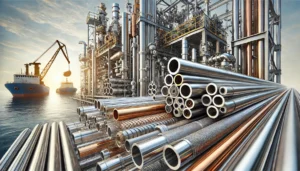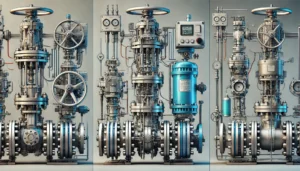In the industry, pipelines need to be both safe and reliable. Pipelines are constructed under strict quality control and severe inspections, and tests, and are also marked in a specific manner. This guide focuses on the key procedures associated with maintaining the integrity of such structures and takes an in-depth look into each crucial procedure.
1. Metallurgical Testing: Material Composition Evaluation
Metallurgical tests are performed to ensure that a pipes material composition has been made according to standard specifications. These evaluations are sub-categorized into:
Micro Analysis: Determines the proportion of alloying elemental constituents of raw materials, final products, and welds to all within the set guidelines.
Macro Analysis: Assesses welds to determine the degree and uniformity of welding between the weld material and the parent material stabilizing base metal.
On structures intended to operate in aggressive environments, other tests are utilized such as: Grain Size Analysis, IGC, ferrite content, HIC and SSC assessments.
2. Destructive Testing: Verification of Mechanical Strength
Destructive tests are done to test the mechanical characteristics of a specific pipe to stand the test of specification materials requirements.
Tensile Test: Tests the yield strength and ultimate tensile strength.
Bend Test: Tests the strengths that weld joints hold.
Flattening Test: It investigates whether the pipe can be plastically deformed.
Impact Test (Charpy V-Notch): It determines the toughness of the material at lower temperatures.
Creep Test: It looks at the effect of temperature over time with a constant force.
3. Non-Destructive Testing (NDT): The Hidden Weaknesses
NDT techniques locate internal as well as surface defects without causing any harm or altering the future capability of the pipe :
Magnetic Particle Inspection (MPI): Reveals surface and subsurface separations.
Ultrasonic Testing (UT): Detections of internal defects are done through sound waves.
Radiographic Testing (RT): Uses X-rays or gamma rays to demonstrate the internal structure, especially for weld seams.
Eddy Current Testing: Detection of surface and sub-surface flaws using electromagnetic induction.
It is sometimes referred to as positive material identification (PMI): it certifies that the material is as intended.
4. Hydrostatic Testing: Checking For Pressure Tightness
Hydrostatic tests are conducted to verify that pipes operable pressure can be imposed on them and they will not leak :
Procedure: Pipes are filled with water and are pressurized to some 1.5 times the design pressure and maintained for certain periods.
Duration Closed spokes are adjusted to hold pressure for at least 5 seconds so as to enable operators look for any leaks along the entire length.
The test pressure (P) can be estimated from the expression: P = 2St/D, where:
S = Allowable stress.
t = Nominal wall thickness
D = Outside diameter
5. Visual and Dimensional Inspections: Ensuring Precision.
Visual inspections look for surface flaws such as scratches, dents or other old welds imperfections such as pores and undercut defects. Dimensional inspections check whether the pipe diameter, wall thickness, length, straightness, ovality and weight are in accordance with provisions. For example, a welded pipe of stainless steel and which has a steel tubing type must have a straightness not exceeding 3.2 mm for undefined lengths of 3.0 meters according to the ASTM A312M (as noted in ASTM A999M).
PROJECT MATERIALS BLOG
6. Marking: Ensuring Traceability and Compliance
When successful in all the tests and inspections, these pipes can be marked with the following information such as:
Logo of the manufacturer.
Material code according to ASTM.
Grade of the material.
Schedule number and size.
Length.
Heat number.
Some additional markings like “WR” for weld repair.
Paint, hard stamping or stenciling are some of the devices that can be used in marking. On the other hand, for carbon steel pipes, hard stamping is not used for thickness less than 6 mm ; for stainless steel, less than 12 mm. This is to avoid compromise of the material.
7. Packing: Protecting During Transit
Pipes ends are covered with caps in order to avoid any breakage during transport. End spider supports may be applied to the ends of larger diameter pipes for maintaining circularity and structural soundness.
Conclusion
A complex methodology is applied while assessing the quality and reliability of pipes which includes the integration of metallurgical studies, mechanical and destructive testing, non-destructive testing, and marking. With the observance of these neat processes, the industries are able to uphold the required standards of the safety and efficiency of their piping systems.










